Cisco ACS 5.X Integration with RSA SecurID Token Server
Available Languages
Contents
Introduction
This document describes how to integrate a Cisco Access Control System (ACS) Version 5.x with RSA SecurID authentication technology.
Background Information
The Cisco Secure ACS supports the RSA SecurID server as an external database.
RSA SecurID two-factor authentication consists of the user's personal identification number (PIN) and an individually registered RSA SecurID token that generates single-use token codes based on a time code algorithm.
A different token code is generated at fixed intervals, usually every 30 or 60 seconds. The RSA SecurID server validates this dynamic authentication code. Each RSA SecurID token is unique, and it is not possible to predict the value of a future token based on past tokens.
Thus, when a correct token code is supplied together with a PIN, there is a high degree of certainty that the person is a valid user. Therefore, RSA SecurID servers provide a more reliable authentication mechanism than conventional reusable passwords.
You can integrate a Cisco ACS 5.x with RSA SecurID authentication technology in these ways:
- RSA SecurID agent - Users are authenticated with username and passcode through the native RSA protocol.
- RADIUS protocol - Users are authenticated with username and passcode through the RADIUS protocol.
Prerequisites
Requirements
Cisco recommends that you have basic knowledge of these topics:
- RSA security
- Cisco Secure Access Control System (ACS)
Components Used
The information in this document is based on these software and hardware versions:
- Cisco Secure Access Control System (ACS) Version 5.x
- RSA SecurID Token Server
The information in this document was created from the devices in a specific lab environment. All of the devices used in this document started with a cleared (default) configuration. If your network is live, make sure that you understand the potential impact of any command.
Configurations
RSA Server
This procedure describes how the RSA SecurID server administrator creates authentication agents and a configuration file. An authentication agent is basically a Domain Name Server (DNS) name and an IP address of a device, software, or service that has rights to access the RSA database. The configuration file basically describes RSA topology and communication.
In this example, the RSA administrator must create two agents for the two ACS instances.
- In the RSA Security Console, navigate to Access > Authentication Agents > Add New:
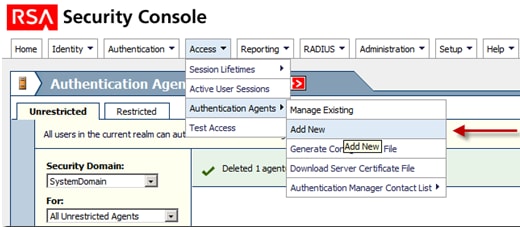
- In the Add New Authentication Agent window, define a Hostname and IP Address for each of the two agents:

Both DNS forward and reverse lookups for ACS agents should work. - Define the Agent Type as Standard Agent:

This is an example of the information you see once the agents are added:

- In the RSA Security Console, navigate to Access > Authentication Agents > Generate Configuration File in order to generate the sdconf.rec configuration file:
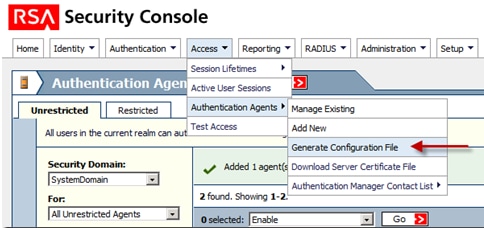
- Use the default values for Maximum Retries and Maximum Time Between Each Retry:
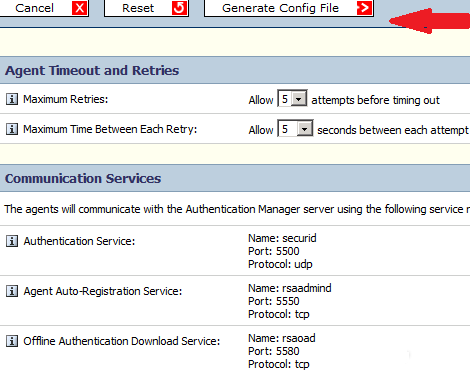
- Download the configuration file:

The .zip file contains the actual configuration sdconf.rec file, which the ACS administrator needs in order to complete configuration tasks.
ACS Version 5.X Server
This procedure describes how the ACS administrator retrieves and submits the configuration file.
- In the Cisco Secure ACS Version 5.x console, navigate to Users and Identity Stores > External Identity Stores > RSA SecurID Token Servers, and click Create:
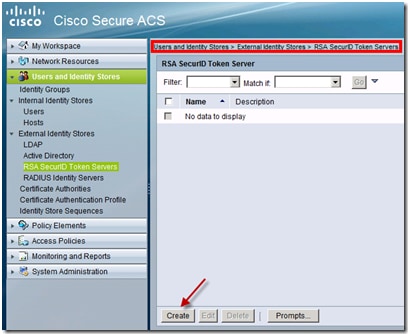
- Enter the name of the RSA server, and browse to the sdconf.rec file that was downloaded from the RSA server:
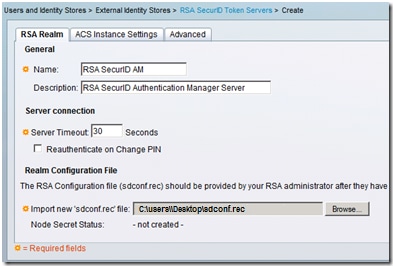
- Select the file, and click Submit.
Verify
Use this section in order to confirm that your configuration works properly.
ACS Version 5.X Server
In order to verify a successful login, go to the ACS console, and review the Hit Count:

You can also review the Authentication Details from the ACS logs:
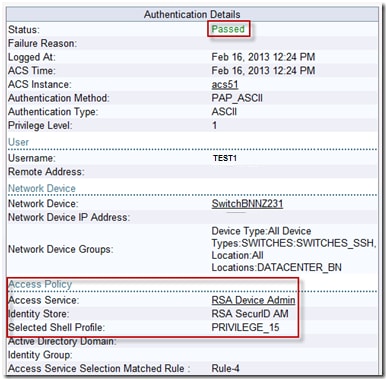
RSA Server
In order to verify successful authentication, go to the RSA console, and review the logs:

Troubleshoot
This section provides information you can use in order to troubleshoot your configuration.
Create an Agent Record (sdconf.rec)
In order to configure an RSA SecurID token server in ACS Version 5.3, the ACS administrator must have the sdconf.rec file. The sdconf.rec file is a configuration record file that specifies how the RSA agent communicates with the RSA SecurID server realm.
In order to create the sdconf.rec file, the RSA administrator should add the ACS host as an agent host on the RSA SecurID server and generate a configuration file for this agent host.
Reset the Node Secret (securid)
After the agent initially communicates with the RSA SecurID server, the server provides the agent with a node secret file called securid. Subsequent communication between the server and the agent relies on the exchange of the node secret in order to verify the other's authenticity.
At times, the administrators might have to reset the node secret:
- The RSA administrator must uncheck the Node Secret Created check box on the Agent Host record in the RSA SecurID server.
- The ACS administrator must remove the securid file from the ACS.
Override Automatic Load Balancing
The RSA SecurID agent automatically balances the requested loads on the RSA SecurID servers in the realm. However, you have the option to manually balance the load. You can specify the server used by each of the agent hosts. You can assign a priority to each server so that the agent host directs authentication requests to some servers more frequently than others.
You must specify the priority settings in a text file, save it as sdopts.rec, and upload it to the ACS.
Manually Intervene to Remove a Down RSA SecurID Server
When an RSA SecurID server is down, the automatic exclusion mechanism does not always work quickly. Remove the sdstatus.12 file from the ACS in order to speed up this process.
Revision History
| Revision | Publish Date | Comments |
|---|---|---|
1.0 |
13-Feb-2014 |
Initial Release |









 Feedback
Feedback